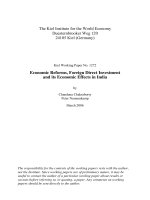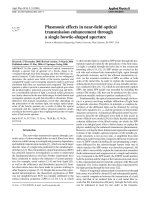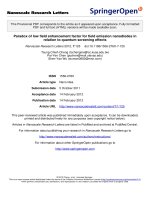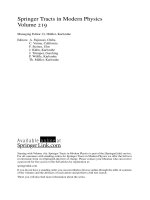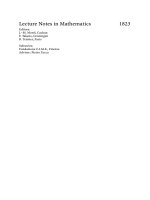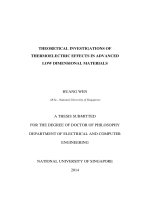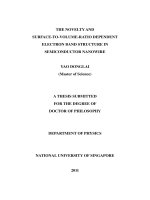fowler-nordheim field emission effects in semiconductor nanostructures
Bạn đang xem bản rút gọn của tài liệu. Xem và tải ngay bản đầy đủ của tài liệu tại đây (2.7 MB, 361 trang )
Springer Series in
solid-state sciences 170
Springer Series in
solid-state sciences
Series Edi tors:
M. Cardona P. Fulde K. von Klitzing R. Merlin H J. Queisser H. St
¨
ormer
The Springer Series in Solid-State Sciences consists of f undamental scientif ic books pre-
pared by leading researchers in the field. They strive to communicate, in a systematic and
comprehensive way, the basic principles as well as new developments in theoretical and
experimental solid-state physics.
Please view available titles in Springer Series in Solid-State Sciences
on series homepage />Sitangshu Bhattacharya
Kamakhya Prasad Ghatak
Fowler-Nordheim
Field Emission
Effects in Semiconductor Nanostruc tures
123
With 79 Figures
Dr. Sitangshu Bhattacharya
Indian Institute of Science, Ctr. Electronics Design and Technology
Nano Scale Device Research Laboratory
Bangalore, India
Professor Dr. Kamakhya Prasad Ghatak
University of Calcutta, Department of Electronic Science
Acharya Prafulla Chandra Rd. 92, 700009 Kolkata, India
Series Editors:
Professor Dr., Dres. h. c. Manuel Cardona
ProfessorDr.,Dres.h.c.PeterFulde
∗
Professor Dr., Dres. h. c. Klaus von Klitzing
Professor Dr., Dres. h. c. Hans-Joachim Queisser
Max-Planck-Inst itut f
¨
ur Festk
¨
orperforschung, Heisenbergstrasse 1, 70569 Stuttgart, Germany
∗
Max-Planck-Inst itut f
¨
ur Physik komplexer Systeme, N
¨
othnitzer Strasse 38
01187 Dresden, Germany
ProfessorDr.RobertoMerlin
Department of Physics, University of Michigan
450 Church Street, Ann Arbor, MI 48109-1040, USA
ProfessorDr.HorstSt
¨
ormer
Dept. Phys. and Dept. Appl. Physics, Columbia University, New York, NY 10027 and
Bell Labs., Lucent Technologies, Mur ray Hill, NJ 07974, USA
Springer Series in Solid-State Sciences ISSN 0171-1873
ISBN 978-3-642-20492-0
e-ISBN 978-3-642-20493-7
DOI 10.1007/978-3-642-20493-7
Springer Heidelberg Dordrecht London New York
This work is subject to copyright. All rights are reserved, whether the whole or part of the material is
concerned, specifically the rights of translation, reprinting, reuse of illustrations, recitation, broadcasting,
reproductiononmicrofilmorinanyotherway,andstorageindatabanks.Duplicationofthispublicationor
parts thereof is permitted only under the provisions of the German Copyright Law of September 9, 1965, in
its current version, and permission for use must always be obtained from Springer. Violations are liable to
prosecution under the German Copyright L aw.
The use of general descriptive names, registered names, trademarks, etc. in this publication does not imply,
even in the absence of a specific statement, that such names are exempt from the relevant protective laws and
regulations and therefore free for general use.
Printed on acid-free paper
Springer is part of Springer Science+Business Media (www.springer.com)
© Springer-Verlag Berlin Heidelberg 2012
LibraryofCongressControlNumber: 2011942324
This book is dedicated to Mr. Ishwar Prasad
Bhattacharya and Mrs. Bela Bhattacharya,
parents of the first author, and
Late Dr. Abhoyapada Ghatak and Mrs. Mira
Ghatak, parents of the second author
•
Preface
With the advent of modern quantized structures in one, two, and three dimensions
(such as quantum wells, nipi structures, inversion and accumulation layers, quantum
well superlattices, carbon nanotubes, quantum wires, quantum wire superlattices,
quantum dots, magneto inversion and accumulation layers, quantum dot super-
lattices, etc.), there has been a considerable interest to investigate the different
physical properties of not only such low-dimensional systems but also the different
nanodevices made from them and they unfold new physics and related mathematics
in the whole realm of solid state sciences in general. Such quantum-confined
systems find applications in resonant tunneling diodes, quantum registers, quantum
switches, quantum sensors, quantum logic gates, quantum well and quantum wire
transistors, quantum cascade lasers, high-resolution terahertz spectroscopy, single
electron/molecule electronics, nanotube-based diodes, and other nanoscale devices.
At field strengths of the order of 10
8
V/m (below the electrical breakdown),
the potential barriers at the surfaces of different materials usually become very
thin resulting in field emission of the electrons due to the tunnel effect. With the
advent of Fowler–Nordheim field emission (FNFE) in 1928 [1, 2], the same has
been extensively studied under various physical conditions with the availability
of a wide range of materials and with the facility for controlling the different
energy band constants under different physical conditions and also finds wide
applications in solid state and related sciences [3–39]. It appears from the detailed
survey of almost the whole spectrum of the literature in this particular aspect that
the available monographs, hand books, and review articles on field emission from
different important semiconductors and their quantum-confined counterparts have
not included any detailed investigations on the FNFE from such systems having
various band structures under different physical conditions.
The research group of A.N. Chakravarti [38, 39] has shown that the FNFE from
different semiconductors depends on the density of states function (DOS), velocity
of the electrons in the quantized levels, and the transmission coefficient of the
electron. Therefore, it assumes different values for different systems and varies with
the electric field, the magnitude of the reciprocal quantizing magnetic field under
magnetic quantization, the nanothickness in quantum wells, wires, and dots, the
vii
viii Preface
quantizing electric field as in inversion layers, the carrier statistics in various types
of quantum-confined superlattices having different carrier energy spectra and other
types of low-dimensional field-assisted systems.
The present monograph is divided into three parts. The first part consists of
four chapters. In Chap. 1, the FNFE has been investigated for quantum wires of
nonlinear optical, III–V, II–VI, bismuth, IV–VI, stressed materials, Te, n-GaP, PtSb
2
,
Bi
2
Te
3
, n-Ge, GaSb, and II–V semiconductors on the basis of respective carrier
energy spectra. Chapter 2 deals with the field emission from III–V, II–VI, IV–VI,
and HgTe/CdTe quantum wires superlattices with graded interfaces have been
studied. The same chapter also explores the FNFE from quantum wire effective
mass superlattices of aforementioned constituent materials. In Chap. 3, the FNFE
from nonlinear optical, III–V, II–VI, bismuth, IV–VI, stressed semiconductors, Te,
n-GaP, PtSb
2
,Bi
2
Te
3
, n-Ge, GaSb, and II–V compounds under strong magnetic
quantization has been studied. In Chap. 4, the FNFE from III–V, II–VI, IV–VI,
and HgTe/CdTe superlattices with graded interfaces and effective mass superlattices
of the aforementioned constituent materials under magnetic quantization have also
been investigated.
The Part II contains the solo Chap.5 and investigates the influence of light
waves on the FNFE from III–V compounds covering the cases of magnetic quan-
tization, quantum wires, effective mass superlattices under magnetic quantization,
superlattices with graded interfaces in the presence of quantizing magnetic field,
quantum wire effective mass superlattices, and also quantum wire superlattices of
the said materials with graded interfaces on the basis of newly formulated carrier
energy spectra. Chapter 6 of the last part deals with the FNFE from quantum
confined optoelectronic semiconductors in the presence of external intense electric
fields. It appears from the literature that the investigations have been carried out
on the FNFE under the assumption that the band structures of the semiconductors
are invariant quantities in the presence of intense electric fields, which is not
fundamentally true. The physical properties of nonparabolic semiconductors in
the presence of strong electric field which changes the basic dispersion relation
have relatively been less investigated [40]. Chapter 6 explores the FNFE from
ternary and quaternary compounds in the presence of intense electric fields on the
basis of electron dispersion laws under strong electric field covering the cases of
magnetic quantization, quantum wires, effective mass superlattices under magnetic
quantization, quantum wire effective mass superlattices, superlattices with graded
interfaces in the presence of quantizing magnetic field, and also quantum wire
superlattices of the said materials with graded interfaces.
Chapter 7 contains different applications and brief review of the experimental
results. In the same chapter, the FNFE from carbon nanotubes in the presence
of intense electric field and the importance of the measurement of band-gap of
optoelectronic materials in the presence of light waves have also been discussed.
Chapter 8 contains conclusion and future research. Besides, 200 open research
problems have been presented which will be useful for the researchers in the
fields of solid state and allied sciences, in general, in addition to the graduate
courses on electron emission from solids in various academic departments of many
Preface ix
Institutes and Universities. We expect that the readers of this monograph will not
only enjoy the investigations of the FNFE for a wide range of semiconductors and
their nanostructures having different energy-wave vector dispersion relation of the
carriers under various physical conditionsas presented in this book but also solve the
said problems by removing all the mathematical approximations and establishing
the appropriate uniqueness conditions, together with the generation of all together
new research problems, both theoretical and experimental. Each chapter except
the last two contains a table highlighting the basic results pertaining to it in a
summarized form.
It is needless to say that this monograph is based on the iceberg principle [41]and
the rest of which will be explored by the researchers of different appropriate fields.
It has been observed that still new experimental investigations of the FNFE from
different semiconductors and their nanostructures are needed since such studies
will throw light on the understanding of the band structures of quantized structures
which, in turn, control the transport phenomena in such k space asymmetric
systems. We further hope that the readers will transform this book into a standard
reference source in connection with the field emission from solids to probe into the
investigation of this particular research topic.
Acknowledgments
Acknowledgment by Sitangshu Bhattacharya: I express my gratitude to my teacher
S. Mahapatra at the Centre for Electronics Design and Technology at Indian Institute
of Science, Bangalore, for his academic advices. I offer special thanks for having
patient to my sister Ms. S. Bhattacharya and my beloved friend Ms. R. Verma and
for standing by my side at difficult times of my research life. I am indebted to the
Department of Science and Technology, India, for sanctioning the project and the
fellowship under ”SERC Fast Track Proposal of Young Scientist” scheme 2008-
2009 (SR/FTP/ETA-37/08) under which this monograph has been completed. As
always, I am immensely grateful to the second author, my friend, philosopher, and
PhD thesis advisor.
Acknowledgment by Kamakhya Prasad Ghatak: I am grateful to A.N.
Chakravarti, my PhD thesis advisor and mentor who convinced an engineering
graduate that theoretical semiconductor physics is the confluence of quantum
mechanics and statistical mechanics, and even to appreciate the incredible beauty,
he placed a stiff note for me to understand deeply the Course of Theoretical Physics,
the Classics of Landau–Lifshitz together with the two volume Classics of Morse–
Feshbach 35 years ago. I am also indebted to P.K. Choudhury, M. Mitra, T. Moulick,
and S. Sarkar for creating the interest in various topics of Applied Mathematics in
general. I consider myself to be rather fortunate to learn quantum mechanics directly
from the Late C.K. Majumdar of the Department of Physics of the University
of Calcutta. I express my gratitude to M. Green, D.J. Lockwood, A.K. Roy,
H.L. Hartnagel, Late P.N. Robson, D. Bimberg, W.L. Freeman, and W. Schommers
x Preface
for various academic interactions spanning over the last two decades. I am grateful
to S.N. Sarkar, EX-Head of my Department, who has been playing a supportive
role in my academic career. The well-known scientist Late P.N. Butcher has been
the main driving force since 1985 before his demise with respect to our scripting
the new series in band structure-dependent properties of nanoscale materials. He
strongly influenced me regarding it and to satisfy his desire, myself with the
prominent members of my research team wrote the Einstein Relation in Compound
Semiconductors and Their Nanostructures, Springer Series in Materials Science,
vol. 116, 2009, as the first one, Photoemission from Optoelectronic Materials and
Their Nanostructures, Springer Series in Nanostructure Science and Technology,
2009, as the second one, Thermoelectric Power in Nanostructured Materials: Strong
Magnetic Fields, Springer Series in Materials Science, vol. 137, 2010, as the third
one, and the present monograph as the fourth one.
I am grateful to R.K. Poddar, Ex-Vice Chancellor of the University of Calcutta,
S.K. Sen, Ex-Vice Chancellor of Jadavpur University, and D.K. Basu, Ex-Vice
Chancellor of Burdwan and Tripura Universities, the three pivotal persons in my
academic career, Myself and D.De are grateful to UGC, India for sanctioning the
research project (No-F 40-469/2011(SR))in this context. Besides, D. De and myself
are grateful to DST, India for sanctioning the fellowship SERC/ET-0213/2011.
My wife and daughter deserve a very special mention for forming the backbone
of my long unperturbed research career. I offer special thanks to P.K. Sarkar of
Semiconductor Device Laboratory, S. Bania of Digital Electronics Laboratory, and
my life-long time tested friend B. Nag of Applied Physics Department for always
standing by me and consoling me at turbulent times.
Joint acknowledgments: Dr. C. Ascheron, Executive Editor Physics, Springer-
Verlag, is our constant source of inspiration since the inception of our first book from
Springer-Verlag and we are grateful to him for his priceless technical assistance
and right motivation. We owe truly a lot to Ms. A. Duhm, Associate Editor
Physics, Springer, and Mrs. E. Suer, assistant to Dr. Ascheron. We are indebted to
Dr D. De, the prominent member of our research group for his academic help. We
offer special thanks to S.M. Adhikari, S. Ghosh, and N. Paitya for critically reading
the manuscript. The production of error-free first edition of any book from every
point of view permanently enjoys the domain of impossibility theorems although
we are open to accept constructive criticisms for the purpose of their inclusion in
the future edition, if any.
Bangalore S. Bhattacharya
Kolkata K.P. Ghatak
July 2011
References xi
References
1. R.H. Fowler, L. Nordheim, Proc. Roy. Soc. London A 119, 173 (1928)
2. A. Van Der Ziel, Solid State Physical Electronics (Prentice-Hall, Englewood Cliffs, 1957),
p. 176
3. B. Mitra, K.P. Ghatak, Phys. Lett. A, 357, 146 (1990)
4. B. Mitra, K.P. Ghatak, Phys. Lett. A 142A, 401 (1989)
5. K.P. Ghatak, M. Mondal, J. Mag. Mag. Mat. 74, 203 (1988)
6. K.P. Ghatak, B. Mitra, Phys. Lett. 156A, 233 (1991)
7. K.P. Ghatak, A. Ghosal, S.N. Biswas, M. Mondal, Proc. SPIE 1308, 356 (1990)
8. V.T. Binh, Ch. Adessi, Phys. Rev. Lett. 85, 864 (2000)
9. R.G. Forbes, Ultramicroscopy 79, 11 (1999)
10. J.W. Gadzuk, E.W. Plummer, Rev. Mod. Phys. 45, 487 (1973)
11. J.M. Beebe, B. Kim, J.W. Gadzuk, C.D. Frisbie, J.G. Kushmerick, Phys. Rev. Lett. 97, 026801
(1999)
12. Y. Feng, J.P. Verboncoeur, Phys. Plasmas 12, 103301 (2005)
13. W.S. Koh, L.K. Ang, Nanotechnology 19, 235402 (2008)
14. M. Razavy, Quantum Theory of Tunneling (World Scientific, Singapore, 2003)
15. S.I. Baranchuk, N.V. Mileshkina, Sov. Phys. Solid State 23, 1715 (1981)
16. P.G. Borzyak, A.A. Dadykin, Sov. Phys. Docklady 27, 335 (1982)
17. S. Bono, R.H. Good, Jr., Surf. Sci. 134, 272 (1983)
18. S.M. Lyth, S.R.P. Silva, Appl. Phys. Lett. 90, 173124 (2007)
19. C. Xu, X. Sun, Int. J. Nanotechnol. 1, 452 (2004)
20. S.D. Liang, L. Chen, Phys. Rev. Lett. 101, 027602 (2008)
21. E.C. Heeres, E.P.A.M. Bakkers, A.L. Roest, M. Kaiser, T.H. Oosterkamp, N. de Jonge, Nano
Lett. 7, 536 (2007)
22. L. Dong, J. Jiao, D.W. Tuggle, J.M. Petty, S.A. Elliff, M. Coulter, Appl. Phys. Lett. 82, 1096
(2003)
23. S.Y. Li, P. Lin, C.Y. Lee, T.Y. Tseng, J. Appl. Phys. 95, 3711 (2004)
24. N.N. Kulkarni, J. Bae, C.K. Shih, S.K. Stanley, S.S. Coffee, J.G. Ekerdt, Appl. Phys. Lett 87,
213115 (2005)
25. K. Senthil K. Yong, Mat. Chem. Phys. 112, 88 (2008)
26. R. Zhou, H.C. Chang, V. Protasenko, M. Kuno, A.K. Singh, D. Jena, H. Xing, J. Appl. Phys.
101, 073704 (2007)
27. K.S. Yeong, J.T.L. Thong, J. Appl. Phys. 100, 114325 (2006)
28. C.H. Oon, S.H. Khong, C.B. Boothroyd, J.T.L. Thong, J. Appl. Phys. 99, 064309 (2006)
29. B.H. Kim, M.S. Kim, K.T. Park, J.K. Lee, D.H. Park, J. Joo, S.G. Yu, S.H. Lee, Appl. Phys.
Lett. 83, 539 (2003)
30. Z.S. Wu, S.Z. Deng, N.S. Xu, J. Chen, J. Zhou, J. Chen, Appl. Phys. Lett. 80, 3829 (2002)
31. Y.W. Zhu, T. Yu, F.C. Cheong, X.J. Xu, C.T. Lim, V.B.C. Tan, J.T.L. Thong, C.H. Sow,
Nanotechnology 16
, 88 (2005)
32. Y.W. Zhu, H.Z. Zhang, X.C. Sun, S.Q. Feng, J. Xu, Q. Zhao, B. Xiang, R.M. Wang, D.P. Yu,
Appl. Phys. Lett. 83, 144 (2003)
33. S. Bhattacharjee, T. Chowdhury, Appl. Phys. Lett. 95, 061501 (2009)
34. S. Kher, A. Dixit, D.N. Rawat, M.S. Sodha, Appl. Phys. Lett. 96, 044101 (2010)
35. I. Shigeo, W. Teruo, O. Kazuyoshi, T. Masateru, U. Satoshi, N. Norio, J. Vac. Sci. Technol.
B: 13, 487 (2009)
36. C.A. Spindt, I. Brodie, L. Humphrey, E.R. Westerberg, J. Appl. Phys. 47, 5248 (2009)
37. Q. Fu, A.V. Nurmikko, L.A. Kolodziejski, R.L. Gunshor, J.W. Wu, Appl. Phys. Lett. 51, 578
(2009)
38. C. Majumdar, M.K. Bose, A.B. Maity, A.N. Chakravarti, Phys. Stat. Sol. (b) 141, 435 (1987)
39. M.K. Bose, C. Majumdar, A.B. Maity, A.N. Chakravarti, Phys. Stat. Sol. (b) 143, 113 (1987)
40. P.K. Chakraborty, S. Choudhury, K.P. Ghatak, Phys. B 387, 333 (2007)
41. A. Pais, J. Robert, Oppenheimer (Oxford University Press, Oxford, 2006), p. xviii
•
Contents
Part I Fowler–Nordheim Field Emission from Quantum
Wires and Superlattices of Nonparabolic
Semiconductors
1 Field Emission from Quantum Wires of Nonparabolic
Semiconductors 3
1.1 Introduction 3
1.2 Theoretical Background 7
1.2.1 The Field Emission from Quantum Wires
of Nonlinear Optical Semiconductors 7
1.2.2 The Field Emission from Quantum Wires
of III–V Semiconductors 11
1.2.3 The Field Emission from Quantum Wires
of II–VI Semiconductors 18
1.2.4 The Field Emission from Quantum Wires of Bismuth 19
1.2.5 The Field Emission from Quantum Wires
of IV–VI Semiconductors 24
1.2.6 The Field Emission from Quantum Wires
of Stressed Semiconductors 26
1.2.7 The Field Emission from Quantum Wires of Tellurium 28
1.2.8 The Field Emission from Quantum Wires
of Gallium Phosphide 29
1.2.9 The Field Emission from Quantum Wires
of Platinum Antimonide 31
1.2.10 The Field Emission from Quantum Wires
of Bismuth Telluride 32
1.2.11 The Field Emission from Quantum Wires of Germanium 34
1.2.12 The Field Emission from Quantum Wires
of Gallium Antimonide 37
1.2.13 The Field Emission from Quantum Wires
of II–V Materials 38
xiii
xiv Contents
1.3 Result and Discussions 39
1.4 Open Research Problems 53
References 63
2 Field Emission from Quantum Wire Superlattices of
Non-parabolic Semiconductors 71
2.1 Introduction 71
2.2 Theoretical Background 72
2.2.1 The Field Emission from III–V Quantum Wire
Superlattices with Graded Interfaces 72
2.2.2 The Field Emission from II–VI Quantum Wire
Superlattices with Graded Interfaces 77
2.2.3 The Field Emission from IV–VI Quantum Wire
Superlattices with Graded Interfaces 82
2.2.4 The Field Emission from HgTe/CdTe Quantum
Wire Superlattices with Graded Interfaces 87
2.2.5 The Field Emission from Quantum Wire III–V
Effective Mass Superlattices 92
2.2.6 The Field Emission from Quantum Wire II–VI
Effective Mass Superlattices 94
2.2.7 The Field Emission from Quantum Wire IV–VI
Effective Mass Superlattices 96
2.2.8 The Field Emission from Quantum Wire
HgTe/CdTe Effective Mass Superlattices 99
2.3 Result and Discussions 101
2.4 Open Research Problems 104
References 106
3 Field Emission from Quantum Confined Semiconductors
Under Magnetic Quantization 109
3.1 Introduction 109
3.2 Theoritical Background 110
3.2.1 The Field Emission from Nonlinear Optical
Semiconductors Under Magnetic Quantization 110
3.2.2 The Field Emission from III–V Semiconductors
Under Magnetic Quantization 112
3.2.3 The Field Emission from II–VI Semiconductors
Under Magnetic Quantization 119
3.2.4 The Field Emission from Under Bismuth
Magnetic Quantization 119
3.2.5 The Field Emission from IV–VI Semiconductors
Under Magnetic Quantization 124
3.2.6 The Field Emission from Stressed
Semiconductors Under Magnetic Quantization 129
Contents xv
3.2.7 The Field Emission from Tellurium Under
Magnetic Quantization 130
3.2.8 The Field Emission from n-Gallium Phosphide
Under Magnetic Quantization 131
3.2.9 The Field Emission from Platinum Antimonide
Under Magnetic Quantization 133
3.2.10 The Field Emission from Bismuth Telluride
Under Magnetic Quantization 135
3.2.11 The Field Emission from Germanium Under
Magnetic Quantization 136
3.2.12 The Field Emission from Gallium Antimonide
Under Magnetic Quantization 138
3.2.13 The Field Emission from II–V Semiconductors
Under Magnetic Quantization 139
3.3 Result and Discussions 140
3.4 Open Research Problems 152
References 153
4 Field Emission of Nonparabolic Semiconductors Under
Magnetic Quantization 157
4.1 Introduction 157
4.2 Theoretical Background 157
4.2.1 The Field Emission from III–V Superlattices
with Graded Interfaces Under Magnetic Quantization 157
4.2.2 The Field Emission from II–VI Superlattices
with Graded Interfaces Under Magnetic Quantization 161
4.2.3 The Field Emission from IV–VI Superlattices
with Graded Interfaces Under Magnetic Quantization 165
4.2.4 The Field Emission from HgTe/CdTe
Superlattices with Graded Interfaces Under
Magnetic Quantization 168
4.2.5 The Field Emission from III–V Effective Mass
Superlattices Under Magnetic Quantization 172
4.2.6 The Field Emission from II–VI Effective Mass
Superlattices Under Magnetic Quantization 173
4.2.7 The Field Emission from IV–VI Effective Mass
Superlattices Under Magnetic Quantization 175
4.2.8 The Field Emission from HgTe/CdTe effective
mass superlattices under magnetic quantization 177
4.3 Result and Discussions 178
4.4 Open Research Problems 181
References 184
xvi Contents
Part II Fowler–Nordheim Field Emission from Quantum-
Confined III–V Semiconductors in the Presence
of Light Waves
5 Field Emission from Quantum-Confined III–V
Semiconductors in the Presence of Light Waves 187
5.1 Introduction 187
5.2 Theoretical Background 187
5.2.1 Field Emission from III–V Semiconductors
Under Magnetic Quantization in the Presence
of Light Waves 187
5.2.2 Field Emission from Quantum Wires of III–V
Semiconductors 192
5.2.3 Field Emission from Effective Mass
Superlattices of III–V Semiconductors
in the Presence of Light Waves Under Magnetic
Quantization 194
5.2.4 Field Emission from Quantum Wire Effective
Mass Superlattices of III–V Semiconductors 200
5.2.5 Field Emission from Superlattices of III–V
Semiconductors with Graded Interfaces Under
Magnetic Quantization 204
5.2.6 Field Emission from Quantum Wire
Superlattices of III–V Semiconductors with
Graded Interfaces 210
5.3 Result and Discussions 215
5.4 Open Research Problems 221
References 230
Part III Fowler–Nordheim Field Emission from Quantum-
Confined Optoelectronic Semiconductors
in the Presence of Intense Electric Field
6 Field Emission from Quantum-Confined Optoelectronic
Semiconductors 233
6.1 Introduction 233
6.2 Theoretical Background 234
6.2.1 Field Emission from Optoelectronic
Semiconductors Under Magnetic Quantization 234
6.2.2 Field Emission from Quantum Wires
of Optoelectronic Semiconductors 248
6.2.3 Field Emission from Effective Mass
Superlattices of Optoelectronic Semiconductors
Under Magnetic Quantization 249
Contents xvii
6.2.4 Field Emission from Quantum Wire Effective
Mass Superlattices of Optoelectronic Semiconductors 253
6.2.5 Field Emission from Superlattices
of Optoelectronic Semiconductors with Graded
Interfaces Under Magnetic Quantization 256
6.2.6 Field Emission from Quantum Wire
Superlattices of Optoelectronic Semiconductors
with Graded Interfaces 262
6.3 Results and Discussion 267
6.4 Open Research Problem 280
References 280
7 Applications and Brief Review of Experimental Results 281
7.1 Introduction 281
7.2 Applications 281
7.2.1 Debye Screening Length 281
7.2.2 Carrier Contribution to the Elastic Constants 284
7.2.3 Effective Electron Mass 291
7.2.4 Diffusivity–Mobility Ratio 295
7.2.5 Measurement of Bandgap in the Presence
of Light Waves 299
7.2.6 Diffusion Coefficient of the Minority Carriers 302
7.2.7 Nonlinear Optical Response 303
7.2.8 Third-Order Nonlinear Optical Susceptibility 303
7.2.9 Generalized Raman Gain 303
7.3 Brief Review of Experimental Works 304
7.3.1 Field Emission from Carbon Nanotubes
in the Presence of Strong Electric Field 304
7.3.2 Optimization of Fowler–Nordheim (FN) Field
Emission Current from Nanostructured Materials 309
7.3.3 Very Brief Description of Experimental Results
of FNFE from Nanostructured Materials 312
7.4 Open Research Problem 323
References 323
8 Conclusion and Future Research 329
References 333
Material Index 335
Subject Index 337
•
List of Symbols
˛ Band nonparabolicity parameter
˛
11
;˛
22
;˛
33
;˛
23
Energy band constants
N˛
11
; N˛
22
; N˛
33
; N˛
23
System constants
ˇ
1
;ˇ
2
;ˇ
4
;ˇ
5
System constants
1
;
2
;
3
;
4
Energy band constants
ı Crystal field splitting constant
N
ı
0
Band constant
jj
Spin–orbit splitting constant parallel to the C -axis
?
Spin–orbit splitting constant perpendicular to the C -axis
Isotropic spin–orbit splitting constant
0
Interface width in superlattices
1
Energy band constant
0
c
;
00
c
Spectrum constants
Wavelength
O" Strain tensor
" Trace of the strain tensor
" Energy as measured from the center of the band gap E
g
0
"
sc
Semiconductor permittivity
"
0
Permittivity of vacuum
.2r/ Zeta function of order 2r
N
0
Constant of the spectrum
.j C 1/ Complete gamma function
!
0
Cyclotron resonance frequency
Frequency
N System constants
f
1
.k/ Warping of the Fermi surface
f
2
.k/ Inversion asymmetry splitting of the conduction band
Na Constant of the spectrum
a
c
Nearest neighbor C–C bonding distance
a
13
Nonparabolicity constant
a
15
Warping constant
xix
xx List of Symbols
a
0
The width of the barrier for superlattice structures
b
0
The width of the well for superlattice structures
A
10
;B
10
Energy band constants
B Quantizing magnetic field
B
2
Momentum matrix element
c Velocity of light
Nc Constant of the spectrum
C
0
Splitting of the two-spin states by the spin–orbit coupling and the
crystalline field
C
1
Conduction band deformation potential
C
2
Strain interaction between the conduction and valance bands
d
x
;d
y
;d
z
Nanothickness along the x-, y-, and z-directions
e Magnitude of electron charge
E Total energy of the carrier as measured from the band edge in the
absence of any quantization in the vertically upward direction for
electrons or vertically downward directions for holes
E
ij
Subband energy
E Energy of the hole as measured from the top of the valance band in the
vertically downward direction
E
F
1
Fermi energy as measured from the mid of the band gap in the vertically
upward direction in connection with nanotubes
E
FB
Fermi energy in the presence of magnetic quantization as measured
from the edge of the conduction band in the absence of any quantization
in the vertically upward direction
E
Fs
Fermi energy as measured in the presence of intense electric field as
measured from the edge of the conduction band in the vertically upward
direction in the absence of any field
E
i
Energy band constant
E
n
z
Energy of the nth subband
E
F1D
Fermi energy in the presence of two-dimensional quantization as
measured from the edge of the conduction band in the vertically upward
direction in the absence of any quantization
E
g
0
Band gap in the absence of any field
F
sz
Surface electric field along z-axis
F
j
.Á/ One parameter Fermi–Dirac integral of order j
f.E/ Fermi–Dirac occupation probability factor
G Thermoelectric power under strong magnetic field
G
0
Deformation potential constant
g
v
Valley degeneracy
h Planck’s constant
„ Dirac’s constant.Á h= .2//
H Heaviside step function
I
0
Light intensity
I System constants
List of Symbols xxi
k
0
Constant of the energy spectrum
k
B
Boltzmann’s constant
k Electron wave vector
l
x
Sample length along x-direction
N
l; Nm; Nn Matrix elements of the strain perturbation operator
L
0
Period of the superlattices
L
D
Debye screening length
l Band constant
m
0
Free electron mass
m
c
Isotropic effective electron mass at the edge of the conduction band
m
jj
Longitudinal effective electron mass at the edge of the conduction
band
m
?
Transverse effective electron mass at the edge of the conduction band
m
1
Effective carrier mass at the band-edge along x-direction
m
2
Effective carrier mass at the band-edge along y-direction
m
3
The effective carrier mass at the band-edge along z-direction
m
0
2
Effective mass tensor component at the top of the valence band (for
electrons) or at the bottom of the conduction band (for holes)
m
t
The transverse effective mass at k =0
m
l
The longitudinal effective mass at k =0
m
?;1
;m
k;1
Transverse and longitudinal effective electron mass at the edge of the
conduction band for the first material in superlattice
m
r
Reduced mass
m
v
Effective mass of the heavy hole at the top of the valance band in the
absence of any field
m
v
Effective mass of the holes at the top of the valence band
m
˙
t
Contributions to the transverse effective mass of the external L
C
6
and
L
6
bands arising from the
!
k
!
p perturbations with the other bands
taken to the second order
m
˙
l
Contributions to the longitudinal effective mass of the external L
C
6
and
L
6
bands arising from the
!
k
!
p perturbations with the other bands
taken to the second order
m
tc
Transverse effective electron mass of the conduction electrons at the
edge of the conduction band
m
lc
Longitudinal effective electron mass of the conduction electrons at the
edge of the conduction band
m
tv
Transverse effective hole mass of the holes at the edge of the valence
band
m
lv
Longitudinal effective hole mass of the holes at the edge of the valence
band
N
1D
.E/ Density of states function per subbands in 2D quantization
N
c
Effective number of states in the conduction band
n
x
;n
y
;n
z
Size quantum numbers along the x-, y-, and z-directions
xxii List of symbols
E
n
x
;E
n
y
;E
n
z
The quantized energy levels due to infinity deep potential well
along the x-, y-, and z-directions
n
0
Carrier degeneracy
N
2D
.E/ 2D density of states function per subband
N
2DT
.E/ Total 2D density of states function
n Landau quantum number/chiral indices
Nn Band constant
P
0
Momentum matrix element
N
P
Energy band constant
P
k
;P
?
Momentum matrix elements parallel and perpendicular to the
direction of C -axis
N
Q;
N
R Spectrum constants
R
G
Generalized Raman gain
r Set of real positive integers whose upper limit is r
0
or s
0
Nr
0
Radius of the nanotube
N
S
0
Entropy per unit volume
Ns Spectrum constant
s
0
Upper limit of the summation
T Temperature
t
c
Tight binding parameter
t
i
Energy band constants
t
ij
Transmission coefficient
i Integer
v Velocity of the electron
Nv
0
; Nw
0
Constants of the spectrum
V
0
Equal to the addition of the Fermi energy in the corresponding
case and the work function
w
of the material
j
V
G
j
Constant of the energy spectrum
x; y Alloy compositions
Z
0
The nonlinear response from the optical excitation of the free
carriers
NP
.!
1
;!
2
;!
3
/ Third-order nonlinear optical susceptibility
Part I
Fowler–Nordheim Field Emission from
Quantum Wires and Superlattices of
Nonparabolic Semiconductors
•
